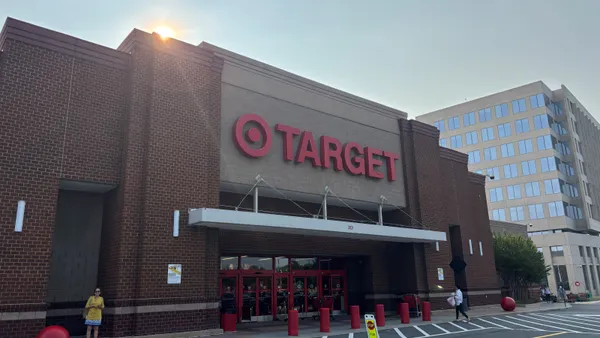Dive Brief:
-
Back-to-school spending by college-bound students and their families is slated to reach $46 billion. While that’s flat with last year, college-related spending in the season will account for 60% of annual college-related purchases this year, and back-to-college spending nearly doubles the expected spend for elementary and high school shopping ($27 billion), according to a Deloitte report emailed to Retail Dive.
-
Back-to-school shoppers are turning to mass merchants this year by far (20% more caregivers or 73% of those shoppers, and 29% more students or 72% of those shoppers), leaving department stores in the dust. Just 34% of parents head to department stores, a 17% drop, and less than a third (30%) of students do, an 11% drop. Off-price stores are gaining, too, with 20% more parents (31% total) and 28% more students (39% total) heading there for back-to-school needs, Deloitte found.
-
Target, Walmart and Amazon are favored by shoppers 18–24 years old, according to a study from Branding Brand on back-to-school consumers in that demographic. Target and Walmart each outpaced Amazon at 64%; Amazon catered to just 50% of young shoppers, even though most (79%) told Branding Brand that they’ll purchase online this year, 62% using their smartphones. If they need to return an online order, most go to a store.
Dive Insight:
The reason college-bound spending outpaces back-to-school shopping is that college students need a broader range of supplies, including furniture and electronics that is found across a wider range of retailers, according to Deloitte.
College-age consumers are looking for deals. Most college students (76%) think of themselves as budget conscious, and they look for free shipping (81%) and used (76%) or rentable (66%) textbooks. Freshmen have the most to accomplish during the season and have the most overall average spend compared to other years at $1,452, Deloitte found. This year, more than half (53%) of freshmen expect to spend more compared to last year’s freshmen class, according to the study.
“Back-to-college shopping is prime time for retailers to create fans that can last a decade or more,” Rod Sides, vice chairman at Deloitte LLP and U.S. retail, wholesale and distribution practice leader, said in a statement. “The students appear to have the most influence on what the family buys for back-to-college, so it makes sense for brands to create those loyalists today, and continue to see the payoff beyond the college years.”
Overall, three in four young shoppers will spend as much as or more than last year, according to Branding Brand, with 22% of shoppers planning to spend more and 53% planning to keep it the same.
While Deloitte found some differences among parents and their college-age kids when it comes to where and how they shop, a lot of them are working closely together. Although caregivers expect to spend more overall this season, 68% say that at least half of their back-to-college shopping is influenced by their kids. That may be fair, considering students are pitching in more these days. More than half (57%) of students say they will contribute more than half of the funds (though their parents see it differently: just 21% agree with that statement).
Nearly half of students (40%) are looking to social media to assist in back-to-college shopping, compared to 18% of parents.
While there may be a clear trend in leveraging the web and smartphones for shopping, generation Z is still quite enamored with brick-and-mortar stores. Most (54%) students ages 10–17 will only buy from physical stores this year, according to another study emailed to Retail Dive from HRC Retail Advisory. They, too, favor mass merchants: 36% say Walmart is their first choice for back-to-school shopping, more than double that of any other retailer. Target ranked second (14%), especially among girls, followed by Amazon (12%), led by boys. Department stores and specialty stores didn’t make the list when ranking the top back-to-school shopping destinations, HRC said.












